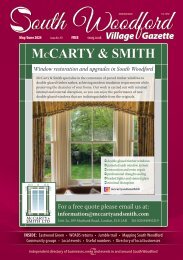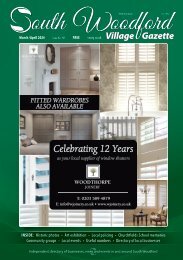March 2022
You also want an ePaper? Increase the reach of your titles
YUMPU automatically turns print PDFs into web optimized ePapers that Google loves.
70<br />
Wanstead Village Directory<br />
HISTORY COMES HOME<br />
Redbridge Museum will open a new permanent exhibition later this<br />
year exploring 200,000 years of local history. In the second of a series of<br />
articles, Museum Officer Nishat Alam looks at some of the items on show<br />
For Women’s History Month, I want<br />
to celebrate a major event in British<br />
women’s history – winning the right to<br />
vote. From the mid-19th century, women<br />
across the country campaigned endlessly<br />
for this right. Redbridge was no exception.<br />
Much like today, Ilford, Wanstead and<br />
Woodford each had their own distinct<br />
identities, often informed by affluence and<br />
class, and this influenced the kinds of suffrage<br />
activity that took place in each area.<br />
In Ilford, campaigners known as ‘suffragettes’<br />
who aligned with the Women’s Social and<br />
Political Union (WSPU) were considered<br />
militant in their approach, smashing shop<br />
windows and setting fire to post boxes to<br />
bring about awareness of their cause. Women<br />
in Wanstead and Woodford tended to be<br />
more conservative. Woodford had its own<br />
branch of the National Union of Women’s<br />
Suffrage Societies who believed in peaceful<br />
protest, distributing petitions and pamphlets<br />
or writing letters to their local MPs. Perhaps<br />
unsurprisingly, the shock factor of the WSPU’s<br />
methods drew more attention, and in 1918<br />
some women were finally given the vote.<br />
One woman who did not stop fighting,<br />
even when both groups suspended their<br />
campaigns during wartime, was Sylvia<br />
Pankhurst. Sylvia had been deeply involved in<br />
WSPU activities; her family had founded the<br />
organisation, she had designed flags, badges<br />
and banners, and had undergone forcefeeding<br />
while on hunger strike in prison. She<br />
was also a pacifist and opposed the WSPU’s<br />
support for the war. As Sylvia’s politics became<br />
increasingly socialist, she was expelled from<br />
the organisation but continued to campaign<br />
with her own working women’s group in<br />
London’s East End.<br />
WSPU membership card<br />
and badge designed by<br />
Sylvia Pankhurst<br />
In 1924, Sylvia moved to Woodford. From her<br />
home on Charteris Road, she campaigned in<br />
support of mothers’ rights and against racism<br />
and fascism for 30 years. She opposed the<br />
Italian colonisation of Ethiopia, and in 1956<br />
was invited to move there by the Emperor<br />
Haile Selassie. She died and was buried in<br />
Addis Ababa in 1960.<br />
Sylvia’s legacy in Redbridge remains and<br />
women continue to connect with her struggle<br />
for social justice. The Anti-Air War Memorial<br />
in Woodford Green, which she commissioned<br />
in 1935, became the site for events held in<br />
the 1980s by the Wanstead and Woodford<br />
Women for Peace, a local activist group<br />
that campaigned against the use of nuclear<br />
weapons during the Cold War.<br />
The story of Sylvia’s life is documented on a<br />
new website (sylviapankhurst.com) and will<br />
be explored through objects, photographs<br />
and film in the new Redbridge Museum.<br />
Redbridge Museum is located on<br />
Clements Road, Ilford. Visit wnstd.com/rm<br />
To complete a survey about what else<br />
should go on display, visit wnstd.com/rms<br />
© Redbridge Museum<br />
To advertise, call 020 8819 6645 or visit wnstd.com

















